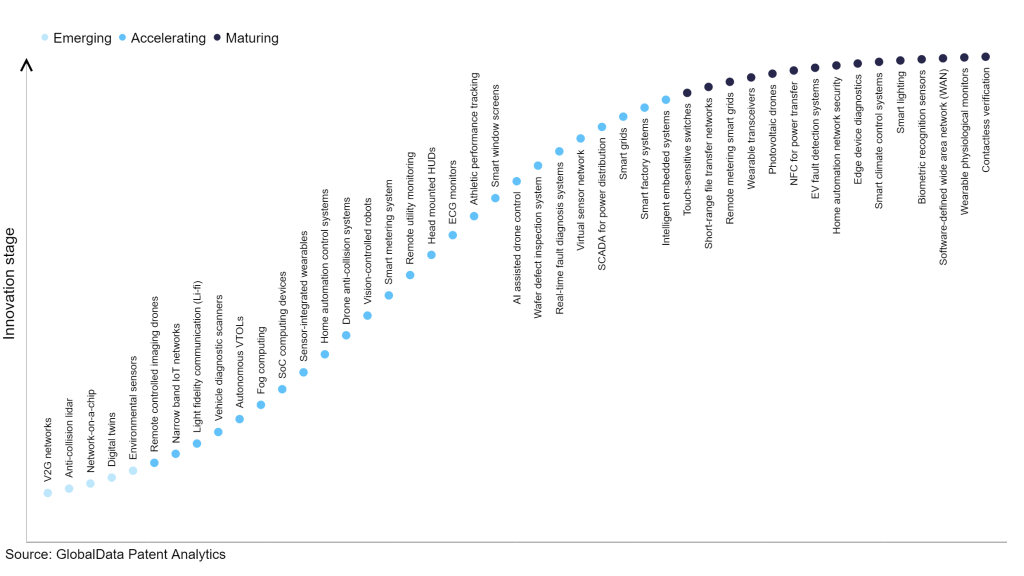The technology industry continues to be a hotbed of innovation, with activity driven by digital transformation, automation, heightened connectivity, and business imperatives to enhance efficiency and gain competitive advantage in an ever-changing marketplace, and growing importance of technologies such as artificial intelligence (AI), computer vision, machine learning, natural language processing, and swarm intelligence in various industrial applications. In the last three years alone, there have been over 3.6 million patents filed and granted in the technology industry, according to GlobalData’s report on Innovation in Internet of Things: AI-assisted drone control. Buy the report here.

Access deeper industry intelligence
Experience unmatched clarity with a single platform that combines unique data, AI, and human expertise.
However, not all innovations are equal and nor do they follow a constant upward trend. Instead, their evolution takes the form of an S-shaped curve that reflects their typical lifecycle from early emergence to accelerating adoption, before finally stabilising and reaching maturity.
Identifying where a particular innovation is on this journey, especially those that are in the emerging and accelerating stages, is essential for understanding their current level of adoption and the likely future trajectory and impact they will have.
300+ innovations will shape the technology industry
According to GlobalData’s Technology Foresights, which plots the S-curve for the technology industry using innovation intensity models built on over 2.5 million patents, there are 300+ innovation areas that will shape the future of the industry.
Within the emerging innovation stage, environmental sensors, digital twins, and network-on-a-chip are disruptive technologies that are in the early stages of application and should be tracked closely. Intelligent embedded systems, smart factory systems, and smart grids are some of the accelerating innovation areas, where adoption has been steadily increasing. Among maturing innovation areas, contactless verification, wearable physiological monitors, and software-defined wide area network are now well established in the industry.
Innovation S-curve for IoT in the technology industry

AI-assisted drone control is a key innovation area in IoT
The utilisation of artificial intelligence (AI) technologies to aid in drone operations is referred to as the AI-assisted drone control. This involves the autonomous navigation of a drone to a specific destination and the avoidance of obstacles. The AI algorithms can analyse vast amounts of data from sensors, cameras, and other sources to enable the drone to make informed decisions and take prompt actions in real time.
GlobalData’s analysis also uncovers the companies at the forefront of each innovation area and assesses the potential reach and impact of their patenting activity across different applications and geographies. According to GlobalData, there are 410+ companies, spanning technology vendors, established technology companies, and up-and-coming start-ups engaged in the development and application of AI-assisted drone control.
Key players in AI-assisted drone control – a disruptive innovation in the technology industry
‘Application diversity’ measures the number of different applications identified for each relevant patent and broadly splits companies into either ‘niche’ or ‘diversified’ innovators.
‘Geographic reach’ refers to the number of different countries each relevant patent is registered in and reflects the breadth of geographic application intended, ranging from ‘global’ to ‘local’.
Among the companies innovating in AI-assisted drone control, Alphabet is the leading patent filer. One of the company’s patents, for example, is aimed at equipping vehicles with one or more computing devices that may receive instructions to pick up a passenger at a pickup location and determine when the vehicle is within a first distance of the pickup location. When the vehicle is within the first distance, the computing devices may make a first attempt to find a spot to park the vehicle and wait for the passenger. When the vehicle is unable to find a spot to park on the first attempt, the computing devices may manoeuvre the vehicle to make a second attempt to find a spot to park the vehicle and wait for the passenger. When the vehicle is unable to find a spot to park on the second attempt, the computing devices may stop the vehicle in a current lane to wait for the passenger.
Other prominent patent filers in the AI-assisted drone control space include Ford Motor and LG.
By geographic reach, Halliburton leads the pack, followed by GAMA Healthcare and BISSELL Homecare. In terms of application diversity, INRIX holds the top position, followed by Yaskawa Electric and Light & Wonder .
The use of AI-assisted drone control technologies is rapidly growing, as drones become more ubiquitous and useful in various industries. These technologies are enabling new capabilities for drones and expanding their use in a variety of applications. By improving accuracy, efficiency, and safety, they are helping to unlock the full potential of drones as a valuable tool for businesses and organisations.
To further understand how IoT is disrupting the technology industry, access GlobalData’s latest thematic research report on Internet of Things – Thematic Research.
Data Insights
From

The gold standard of business intelligence.
Blending expert knowledge with cutting-edge technology, GlobalData’s unrivalled proprietary data will enable you to decode what’s happening in your market. You can make better informed decisions and gain a future-proof advantage over your competitors.







